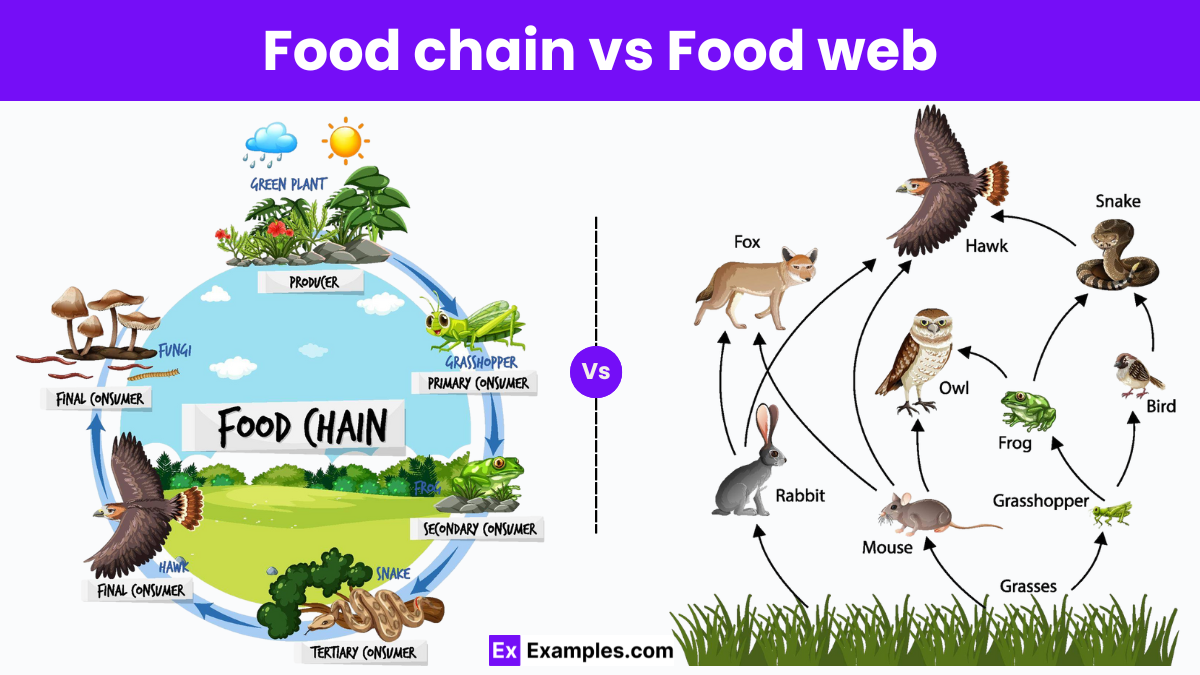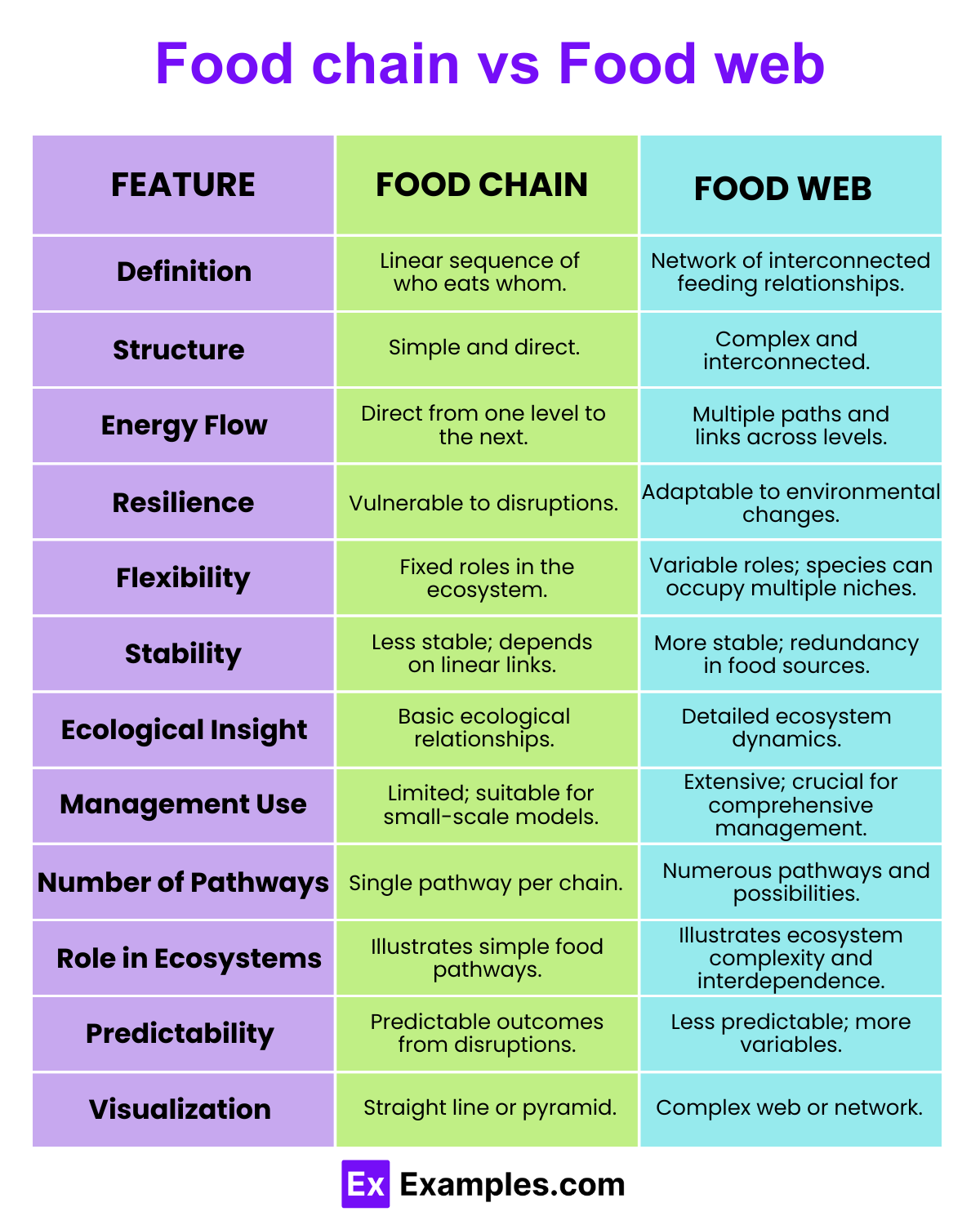Which of the following best describes a food chain?
A complex network of feeding relationships
A single linear pathway of energy transfer
A group of organisms that live in the same habitat
A collection of organisms of the same species


In ecosystems, a food chain illustrates a simple linear sequence where each organism consumes another, while a food web shows complex connections between multiple food chains, depicting diverse dietary relationships. Producers like plants form the base, followed by herbivores, then omnivores and carnivores, with apex predators at the top, essential for maintaining ecological balance by controlling species populations.
A food chain outlines a straightforward sequence within an ecosystem, starting with primary producers like plants and moving up through herbivores to carnivores and apex predators. For example, green algae (primary producers) are eaten by mollusks (primary consumers), which are then consumed by slimy sculpin fish (secondary consumers), ending with Chinook salmon as the apex consumer.
A food web provides a detailed map of feeding relationships within an ecosystem, illustrating how different species are interconnected. It reveals that various species, such as diatoms and green algae, serve as food for creatures like water fleas, which small and large fish then consume, culminating with apex predators like sea lamprey hunting them.

| Aspect | Food Chain | Food Web |
|---|---|---|
| Definition | A sequence that shows the direct transfer of energy between organisms through consumption. | A complex network that depicts multiple feeding relationships between organisms in an ecosystem. |
| Structure | Linear and straightforward, illustrating one pathway of energy flow at a time. | Intricate and reticulate, showing numerous connections and pathways of energy flow. |
| Complexity | Relatively simple, with each organism connected to the next along a single line. | Highly complex, with multiple links between different trophic levels and species. |
| Representation of Ecosystem | Represents a simplified version, ideal for understanding basic predator-prey relationships. | Provides a comprehensive view of all the possible feeding relationships and interdependencies. |
| Flexibility in Ecology | Less flexible, as it does not account for changes in the ecosystem or the impact of losing a species. | More adaptable, showing how organisms can switch between food sources and maintain ecosystem stability. |
| Stability | Generally less stable; if one link in the chain is removed, it can collapse. | More robust, as multiple connections mean the ecosystem can better withstand changes or losses. |
| Ecological Insight | Offers basic ecological insights and is easier to understand for educational purposes. | Offers extensive ecological insights, revealing the complexity and dynamic nature of ecosystems. |
| Use in Ecological Management | Useful for illustrating clear, direct relationships in controlled environments or smaller ecosystems. | Essential for understanding and managing biodiversity in large or complex ecosystems. |
| Examples | Grass → Grasshopper → Frog → Snake → Eagle | Forest ecosystem with plants being eaten by several herbivores, which are in turn eaten by various carnivores. |
A food chain shows a linear sequence of organisms eating each other, while a food web displays complex interconnections and relationships among species.
Quizlet defines a food chain as a simple linear sequence of organisms feeding on each other, contrasting with a food web which illustrates a complex network of feeding interactions.
In a food chain, grass feeds a rabbit, which a fox then eats. In a food web, grass supports various insects and mammals, which are prey for multiple predators.
A food web is more accurate as it represents multiple feeding relationships and interactions within an ecosystem, unlike the simplistic approach of a food chain.
A food web offers a more comprehensive and realistic representation of an ecosystem’s feeding relationships, capturing the complexity and interdependency among different species.

In ecosystems, a food chain illustrates a simple linear sequence where each organism consumes another, while a food web shows complex connections between multiple food chains, depicting diverse dietary relationships. Producers like plants form the base, followed by herbivores, then omnivores and carnivores, with apex predators at the top, essential for maintaining ecological balance by controlling species populations.
A food chain outlines a straightforward sequence within an ecosystem, starting with primary producers like plants and moving up through herbivores to carnivores and apex predators. For example, green algae (primary producers) are eaten by mollusks (primary consumers), which are then consumed by slimy sculpin fish (secondary consumers), ending with Chinook salmon as the apex consumer.
A food web provides a detailed map of feeding relationships within an ecosystem, illustrating how different species are interconnected. It reveals that various species, such as diatoms and green algae, serve as food for creatures like water fleas, which small and large fish then consume, culminating with apex predators like sea lamprey hunting them.
Aspect | Food Chain | Food Web |
|---|---|---|
Definition | A sequence that shows the direct transfer of energy between organisms through consumption. | A complex network that depicts multiple feeding relationships between organisms in an ecosystem. |
Structure | Linear and straightforward, illustrating one pathway of energy flow at a time. | Intricate and reticulate, showing numerous connections and pathways of energy flow. |
Complexity | Relatively simple, with each organism connected to the next along a single line. | Highly complex, with multiple links between different trophic levels and species. |
Representation of Ecosystem | Represents a simplified version, ideal for understanding basic predator-prey relationships. | Provides a comprehensive view of all the possible feeding relationships and interdependencies. |
Flexibility in Ecology | Less flexible, as it does not account for changes in the ecosystem or the impact of losing a species. | More adaptable, showing how organisms can switch between food sources and maintain ecosystem stability. |
Stability | Generally less stable; if one link in the chain is removed, it can collapse. | More robust, as multiple connections mean the ecosystem can better withstand changes or losses. |
Ecological Insight | Offers basic ecological insights and is easier to understand for educational purposes. | Offers extensive ecological insights, revealing the complexity and dynamic nature of ecosystems. |
Use in Ecological Management | Useful for illustrating clear, direct relationships in controlled environments or smaller ecosystems. | Essential for understanding and managing biodiversity in large or complex ecosystems. |
Examples | Grass → Grasshopper → Frog → Snake → Eagle | Forest ecosystem with plants being eaten by several herbivores, which are in turn eaten by various carnivores. |
Trophic Levels: Both food chains and food webs organize organisms into trophic levels, categorizing them based on their primary source of nutrition, from producers at the bottom to apex predators at the top.
Energy Flow: Each illustrates the flow of energy through an ecosystem, beginning with producers who harness solar or chemical energy and passing through various consumers.
Ecological Role: Both concepts help in understanding ecological relationships and the role of organisms within their ecosystems, providing insights into the stability and structure of ecological communities.
Complexity: A food chain is a simple, linear sequence showing direct eating relationships and energy flow from one organism to another. In contrast, a food web is a complex network that maps multiple feeding connections among organisms, demonstrating how different chains overlap.
Resilience to Change: Food webs offer a more robust model of ecosystem dynamics as they illustrate how organisms can adapt their feeding behavior based on availability and competition. This interconnectedness provides greater stability against environmental changes or species losses compared to the more vulnerable linear chains.
Ecological Insight: While food chains provide a clear and straightforward method for teaching basic ecological concepts, food webs deliver a more comprehensive view that mirrors the actual complexity and interdependency seen in natural ecosystems.
Flexibility: Food webs reflect real-world ecosystems more accurately, showing that most organisms have varied diets and might play different roles in multiple food chains. This flexibility in dietary options helps stabilize the ecosystem by reducing dependency on a single food source.
A food chain shows a linear sequence of organisms eating each other, while a food web displays complex interconnections and relationships among species.
Quizlet defines a food chain as a simple linear sequence of organisms feeding on each other, contrasting with a food web which illustrates a complex network of feeding interactions.
In a food chain, grass feeds a rabbit, which a fox then eats. In a food web, grass supports various insects and mammals, which are prey for multiple predators.
A food web is more accurate as it represents multiple feeding relationships and interactions within an ecosystem, unlike the simplistic approach of a food chain.
A food web offers a more comprehensive and realistic representation of an ecosystem’s feeding relationships, capturing the complexity and interdependency among different species.
Text prompt
Add Tone
10 Examples of Public speaking
20 Examples of Gas lighting
Which of the following best describes a food chain?
A complex network of feeding relationships
A single linear pathway of energy transfer
A group of organisms that live in the same habitat
A collection of organisms of the same species
In a food web, how are different food chains related?
They operate independently of each other.
They are interconnected and overlap.
They compete with each other for resources.
They exist in different ecosystems.
Which of the following is a primary producer in a food chain?
Grass
Rabbit
Fox
Hawk
Which statement is true about a food web compared to a food chain?
A food web is simpler than a food chain.
A food web contains many interrelated food chains.
A food web shows only one path of energy flow.
A food web includes only herbivores and carnivores.
In a food chain, what role do decomposers play?
Primary producers
Primary consumers
Secondary consumers
Recyclers of nutrients
What is the main difference between a food chain and a food web?
A food chain is more complex than a food web.
A food web represents multiple feeding relationships, while a food chain is a single sequence.
A food web only includes decomposers, while a food chain does not.
A food chain involves multiple organisms of the same species.
Which of the following best describes a trophic level in a food web?
The total number of organisms in an ecosystem
The position of an organism in the food chain or web
The physical habitat of an organism
The genetic diversity within a population
Why are food webs considered more stable than food chains?
They have fewer species.
They include only one type of organism.
They provide multiple pathways for energy flow.
They do not involve decomposers.
Which of the following is an example of a secondary consumer in a food web?
Algae
Grasshopper
Frog
Eagle
In a food web, what happens if a top predator is removed?
The primary producers will increase in number.
The population of prey species will increase.
The ecosystem will remain unaffected.
Decomposers will take over the role of top predator.
Before you leave, take our quick quiz to enhance your learning!

